This post was last updated on February 22nd, 2023
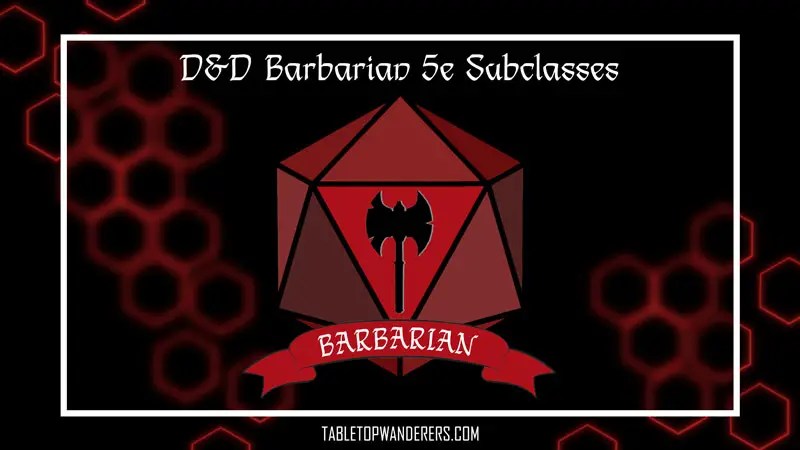
Hi fellow gamer and welcome to another Dungeons & Dragons article, this time focused on the Barbarian 5e subclasses called Primal Paths.
In my previous Barbarian level-up guide article I said how I find the level-up process to be one of the most enjoyable parts of any RPG and one of the nuances I prefer when I level up is to find ways to differentiate my character from the rest of the party, which is when subclasses come into play.
The Barbarian is mainly seen as a classic fighter with little intelligence that always rushes into battle without thinking about the consequences, but this is a generalization that doesn’t do justice to a deeper and quite versatile class.
There are currently 8 Barbarian 5e subclasses across different D&D manuals.
For each of them, I’ll write a general overview and at the end of the article, you’ll also find the Barbarian 5e subclasses ranked following my personal taste which takes multiple factors into consideration, with the role-playing and playstyle potential of the class in the first place.
This post may contain affiliate links. If you click through and make a purchase, I will get a commission at no extra cost to you. See our Affiliate Disclosure.
D&D Barbarian 5e Subclasses
- Ancestral Guardian Barbarian 5e
- Battlerager Barbarian 5e
- Beast Barbarian 5e
- Berserker Barbarian 5e
- Storm Herald Barbarian 5e
- Totem Warrior Barbarian 5e
- Wild Magic Barbarian 5e
- Zealot Barbarian 5e
Ancestral Guardian Barbarian 5e
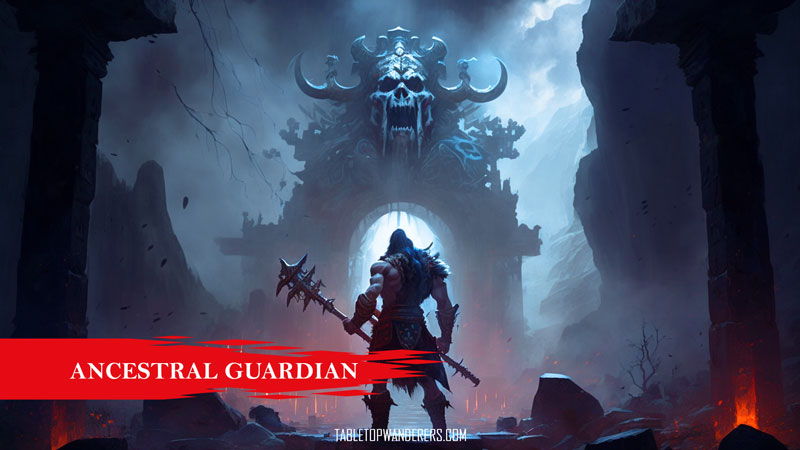
Subclass Overview
The Ancestral Guardian Barbarian is a character who reveres his ancestors, as they are seen as mighty spirits who could guide and protect living creatures.
These barbarians are often covered by tattoos that depict prestigious victories against terrifying monsters and other formidable rivals.
An Ancestral Guardian who enters the Rage state communicates with the spirit world and summons spectral warriors that will help in battle.
D&D Manual: Xanathar’s Guide to Everything.
Ancestral Guardian Main Features
Ancestral Protectors – 3rd level
This is the first subclass feature you gain at the 3rd level and allows spectral warriors to appear when you enter your rage.
These spirits will target the first creature you hit with an attack on your turn and they’ll hinder that opponent. The effects triggered by this feature are two:
- the target has disadvantage on any attack roll that isn’t against you until the beginning of your next turn;
- if the target makes an attack against a creature other than you, that creature has resistance to the damage the attack causes.
Spirit Shield – 6th level
The power of your ancestral protectors increases to the point where they can provide supernatural protection to your allies.
While you’re raging, if another creature you can see within 30 feet gets hit by an enemy, you can use your reaction to reduce that damage by 2d6 (this value will increase when you reach certain levels).
Consults the Spirits – 10th level
You earn the ability to communicate with your ancestral spirits; you can cast augury or clairvoyance spells using your Wisdom as spellcasting ability without consuming any spell slots.
Vengeful Ancestors – 14th level
Your Ancestral Spirits are now strong enough to take revenge, therefore each time you reduce attack damage using Spirit Shield, the opponent takes an amount of damage equal to the prevented damage.
Party Role
Classic Tank & Defensive Support.
Battlerager Barbarian 5e
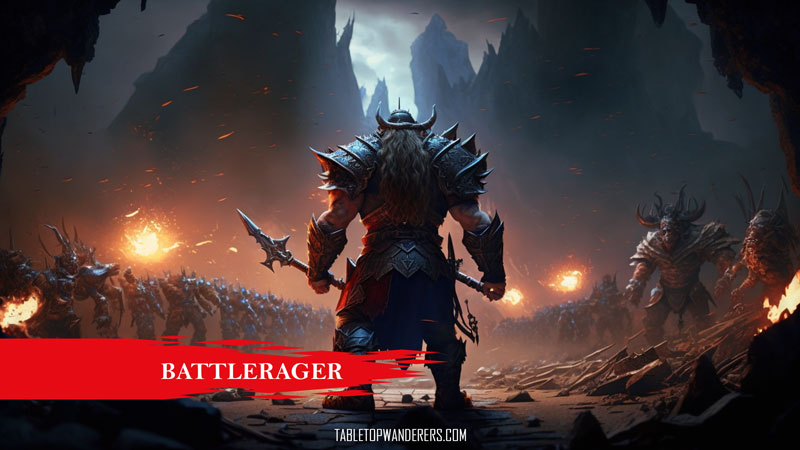
Subclass Overview
The Battlerager Barbarian is a character who specialises in wearing bulky and spiked armour.
He throws himself into combat and strikes enemies with his armoured body while indulging in the fury of battle.
Only dwarves can follow this Primal Path though, as the battlerager is a particular niche of their society; so if you want to play this subclass, your character has to be a dwarf.
D&D Manual: Sword Coast Adventurer’s Guide.
Battlerager Main Features
Battlerager Armour – 3rd level
The first feature of this subclass allows you to wear spiked armour, which is a rare medium armour made by dwarves.
If you enter rage while you’re wearing this armour, you can make one melee weapon attack, as a bonus attack, against an enemy within 5 feet from you.
The amount of damage the spikes deal will be 1d4 piercing damage that uses your strength as a modifier.
You can deal 3 additional piercing damage if you grapple an enemy.
Reckless Abandon – 6th level
When you use Reckless Attack while raging, you’ll gain temporary hit points equal to your Constitution modifier. They vanish when your rage ends.
Battlerager Charge – 10th level
You can use the Dash action as a bonus action while you’re raging.
Spiked Retribution – 14th level
If you are in rage status and you’re wearing the spiked armour, all the enemies within 5 feet that hit you with a melee attack will get 3 piercing damage.
Party Role
Classic Tank focused on Damage.
Beast Barbarian 5e
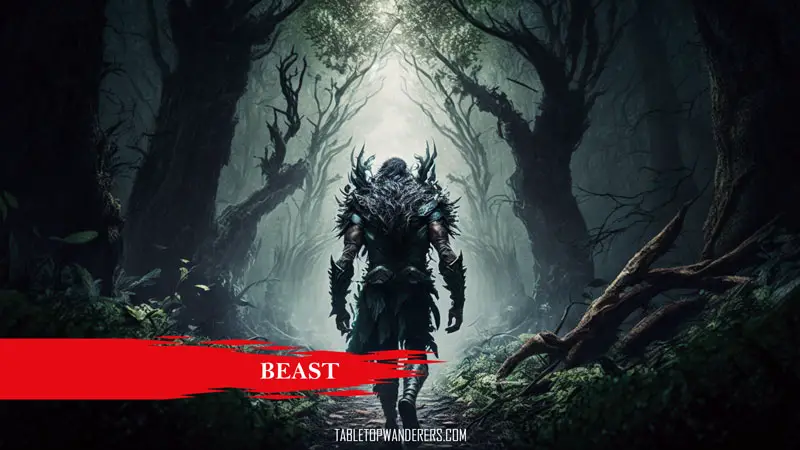
Subclass Overview
The Beast Barbarian is a character who embraces his own feral instincts and he is guided by the bestial spark that dwells deep within his soul.
A barbarian who follows the Path of the Beast might be inhabited by a primal spirit or be a descendant of shape-shifters, such as lycanthrope.
Not only do the raging barbarians gain strength from their inner beast, but they also physically transform into a beast.
D&D Manual: Tasha’s Cauldron of Everything.
Beast Main Features
Form of the Beast – 3rd level
While you’re raging you can transform parts of your body into feral weapons that can be chosen each time you transform.
There are 3 different weapon forms, each with different advantages and attack power:
- bite: your mouth is transformed into a bestial muzzle or great mandibles that can deal 1d8 piercing damage.
- claws: your hands transform into a claw and you can use them as a weapon if you’re not holding a weapon already; each claw deals 1d6 slashing damage.
- tail: a spiny tail will grow at the bottom of your back and it deals 1d8 piercing damage.
Bestial Soul – 6th level
The Bestial Soul feature grants you two quite useful things.
The first is that your feral power increases with the effect that your natural weapon, described above, is now counted as magical for the purpose of overcoming resistance and immunity to nonmagical attacks.
The second and very unique effect is that when you finish a short or long rest you’ll be granted one of the following benefits that will last until your next short or long rest:
- you can breathe underwater and your swimming speed increases to be identical to your walking pace;
- you can climb challenging surfaces without doing any ability checks and your climbing speed increases to match your walking speed;
- you can extend your jump by a number of feet equal to the total of a Strength (Athletics) check you make before jumping.
Infectus Fury – 10th level
Your natural weapons are becoming even more deadly and thanks to this feature when you hit a target with a bite, claw or tail attack while you’re raging, the feral beast within you could curse the target.
If the creature you hit fails a Wisdom saving throw will suffer one of these effects of your choice:
- the target must make a melee attack against another creature decided by you using its reaction;
- the target takes 2d12 psychic damage.
Call the Hunt – 14th level
Your inner beast becomes so strong that you may unleash its ferocity on others and earn strength from having them join your blood thirst.
While you’re raging you can choose a number of creatures within 30 feet of you and gain 5 temporary hit points for each creature that accepts your inner beast influence.
The creatures under the influence of your beast earn the benefit of rolling an extra d6 and add to value to the damage.
Party Role
Offensive and Defensive Tank.
Berserker Barbarian 5e
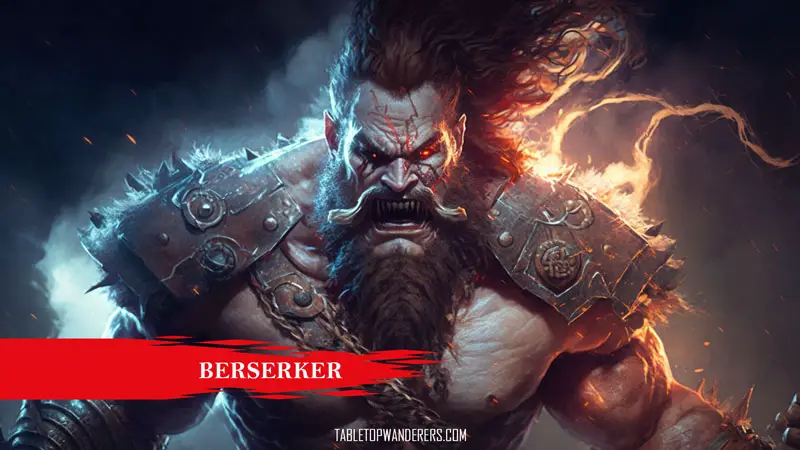
Subclass Overview
The Path of the Berserker is a bloody, unrestrained path of rage. You revel in the mayhem of combat fueled by the berserker’s anger, paying no attention to your own health or well-being.
All your strength and will are aimed to achieve a specific mission: the destruction of your enemies.
D&D Manual: Player’s Handbook.
Berserker Main Features
Frenzy – 3rd level
This is the most obvious feature that can be found in almost every existing RPG when you think about a berserker.
You can enter a frenzy status when you rage and this guarantee you an additional single melee attack as a bonus action.
The price to pay for this extremely valuable bonus is that you get a level of exhaustion when the rage ends.
Mindless Rage – 6th level
You can’t be charmed or frightened while you’re raging and if you are under the effect of one of those statuses, entering rage will suspend the effect.
Intimidating Presence – 10th level
You’re so strong that you can use an action to intimidate someone with your menacing presence.
Retaliation – 14th level
If you take any damage from a creature within 5 feet of you, you can use your reaction to hit that creature with a melee weapon attack.
Party Role
Classic Offensive Tank.
Storm Herald Barbarian 5e
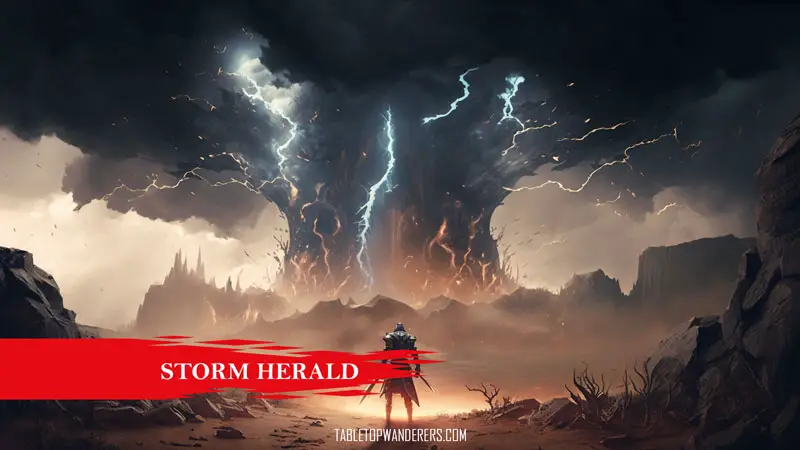
Subclass Overview
Barbarians are filled with inner rage that increases their strength, durability and speed and those who follow the Path of the Storm Herald are taught to channel their anger into primordial magic.
When a Storm Herald barbarian enters rage he can create strong magical effects harnessing the power of natural environments such as Desert, Sea or Tundra.
D&D Manual: Xanathar’s Guide to Everything.
Storm Herald Main Features
Storm Aura – 3rd level
When you enter rage you can emanate a stormy aura that expands in every direction within 10 feet of you.
You can choose one of the 3 elemental environments and apply the effect as a bonus action on each of your turns:
- Desert: all the creatures in your aura take 2 fire damage each;
- Sea: you can choose a target that has to make a Dexterity saving throw and in case of failure he will take 1d6 lightning damage;
- Tundra: each of the creatures chosen by you that are in your aura gains 2 additional hit points.
Storm Soul – 6th level
The Storm inside you grants you benefits even when your aura isn’t activated, and these effects vary depending on the chosen elemental environment.
- Desert: you are resistant to fire damage and don’t suffer the effects of extreme heat. You can also set a flammable object on fire using an action;
- Sea: you are resistant to lightning damage and can breathe underwater;
- Tundra: you are resistant to cold damage and don’t suffer the effects of extreme cold. Additionally, you can touch the water and turn a 5-foot cube of it into ice.
Shielding Storm – 10th level
You have learnt how to control the Storm to protect others. This means that each creature of your choice gains the same elemental damage resistance you have based on the Storm Soul you have chosen, therefore fire, lightning or ice.
The creatures you want to protect have to be inside your aura to benefit from this effect.
Raging Storm – 14th level
The power of your Storm grows immensely and you gain new powerful effects that will benefit your party.
- Desert: if a creature within your aura hits you with an attack you can use your reaction to force that creature to make a Dexterity saving throw. You can inflict damage equal to half your Barbarian level if that creature fails the saving throw;
- Sea: when you hit a creature within your aura you can use your reaction to force that creature to make a Strength saving throw. If that creature fails the saving throw it will be knocked prone;
- Tundra: Whenever the Storm Aura feature’s effect is activated, you can choose a creature within your aura. If the creature fails a Strength saving throw its speed will be reduced to 0.
Party Role
Defensive Tank.
Totem Warrior Barbarian 5e
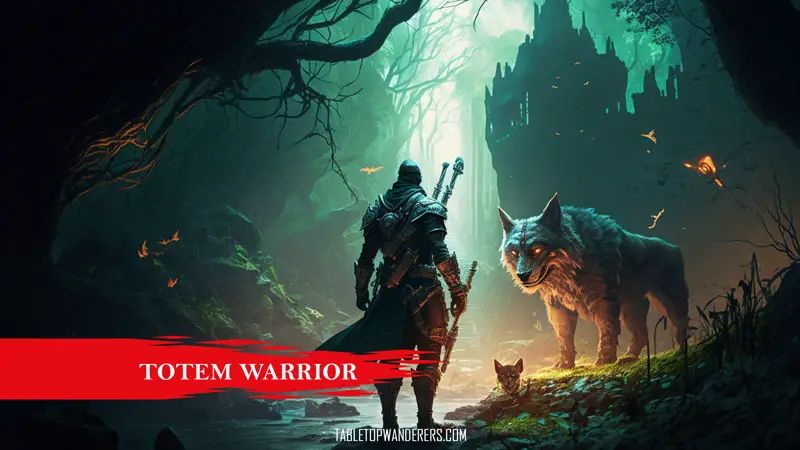
Subclass Overview
When you choose to follow the Path of the Totem Warrior, you’ll be granted the assistance of a spiritual animal that will enormously boost your strength along with guiding and protecting you.
Your spiritual journey as a Totem Warrior starts at level 3 when you’ll have to choose a totem spirit. This companion can remain the same during your level-ups or you can choose something else.
Totem Spirits in the Players’ Handbook are the Bear, Eagle and Wolf but they can be swapped for similar animals that better describe where your character comes from.
D&D Manual: Player’s Handbook.
Totem Warrior Main Features
Spirit Seeker – 3rd level
You earn the ability to cast the Beast Sense and Speak with Animals spells. These can only be cast as rituals.
Totem Spirit – 3rd level
You choose a Totem Spirit among Bear, Eagle and Wolf (or similar) and gain its feature. You also gain minor physical attributes that reflect the chosen animal.
- Bear: when you’re raging you’re resistant to any damage except psychic;
- Eagle: when you’re raging other creatures have disadvantage if they try opportunity attacks against you, and you can use the dash action as a bonus action;
- Wolf: if you’re raging your allies have advantage on melee attack rolls against any enemy within 5 feet of you.
- Elk: while you’re raging your walking speed increases to 15 feet if you don’t wear heavy armour.
- Tiger: when you’re raging you can add 10 feet to your long jumps and 3 feet to your high jumps.
Aspect of the Beast – 6th level
Based on the animal you choose you’ll gain a magical effect.
- Bear: the might of a bear will double your carrying capacity and give you advantage on Strength checks such as push, lift, pull or break objects.
- Eagle: the eyesight of an eagle will allow you to see up to 1 mile without no difficulty and you’ll be able to captivate every small detail if you’re looking at something within 100 feet from your position.
- Wolf: the hunting sensibilities of a wolf will allow you to track other creatures while travelling at a fast pace and you’ll be able to move stealthily even if you’re moving at normal speed.
- Elk: your travel speed and the travel speed of up to ten of your allies within 60 feet of you is doubled.
- Tiger: you earn 2 proficiencies of your choice among athletics, acrobatics, stealth and survival.
Spirit Walker – 10th level
You can cast the Commune with Nature spell as a ritual.
Totemic Attunement – 14th level
Based on the animal you choose you’ll gain another powerful magical effect.
- Bear: while you’re raging any creatures within 5 feet of you have disadvantage on attack rolls against your allies.
- Eagle: while you’re raging your flying speed equals your walking speed.
- Wolf: while you’re raging you can knock enemies prone when you strike them with melee weapon attacks.
- Elk: when you’re raging you can use a bonus action to travel through the space of a large or smaller creature. That creature must succeed in a saving throw otherwise it will be knocked prone and will be hit with a 1d12 + Strength modifier bludgeoning damage.
- Tiger: You can use a bonus action to make an extra melee weapon attack while you’re raging if you travel at least 20 feet straight in the direction of a large or smaller target just before making a melee weapon attack against it.
Party Role
Classic Tank focused on Damage.
Wild Magic Barbarian 5e
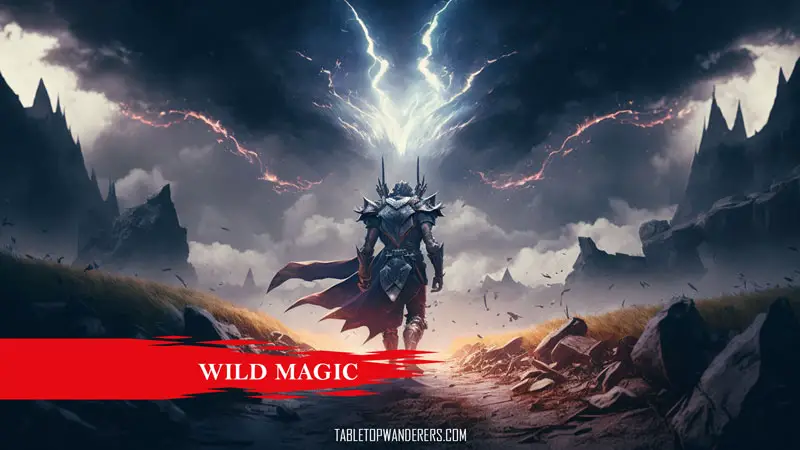
Subclass Overview
A barbarian who follows the Path of the Wild Magic is someone who supernatural forces and rampant magic spread in the universe have particularly influenced.
Barbarians are particularly vulnerable to these effects since they have strong emotions, and some get changed by magic.
The most common races that follow this Path are elves, tieflings, aasimar and genasi who are keen to show the world the power of their ancestors.
D&D Manual: Tasha’s Cauldron of Everything.
Wild Magic Main Features
Magic Awareness – 3rd level
On your turn you can use an action to open your awareness to the presence of magic, with the result of being able to locate any spell or magic item within 60 feet of you.
Wild Surge – 3rd level
When you enter rage you can roll on the Wild Magic table and apply the magical effect among 8 powerful possibilities.
Bolstering Magic – 6th level
You can strengthen yourself or a friend by using your wild magic. You can use an action to touch a creature that will be granted one of the following effects of your choice:
- For 10 minutes that blessed creature can roll a d3 and add the number to any attack roll or ability check.
- The chosen creature can roll a d3 and regains a spell slot of the level that equals the number rolled.
Unstable Backlash – 10th level
While you’re raging you can use your reaction to roll on the Wild Magic table right away after taking damage or failing a saving throw, and the result takes effect right away.
Controlled Surge – 14th level
This powerful upgrade allows you to roll the die twice whenever you roll on the Wild Magic table and you can choose the effect to unleash among the 2 rolled numbers.
You can select any effect on the Wild Magic table and disregard the result if both dice had the same number.
Party Role
Offensive Tank.
Zealot Barbarian 5e
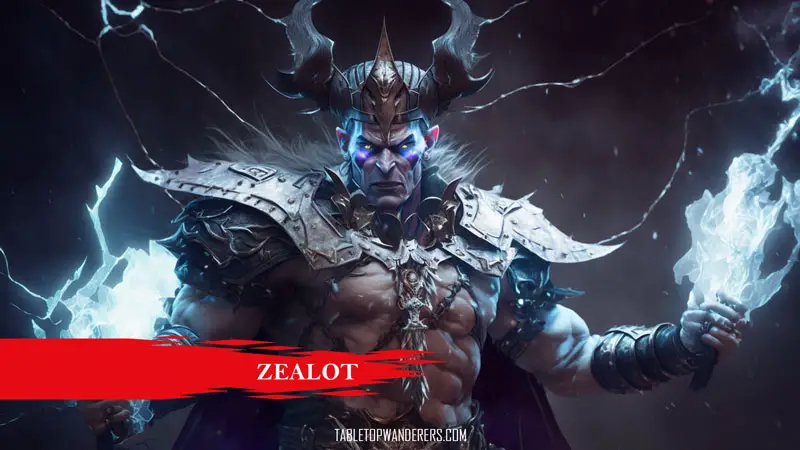
Subclass Overview
Barbarians who become Zealots are the ones that have been guided by different gods to embrace the fury of ferocious battles.
These zealot-warriors are barbarians who transform their fury into impressive manifestations of divine power.
Zealots are typically motivated by gods of conflict, destruction, and violence.
D&D Manual: Xanathar’s Guide to Everything.
Zealot Main Features
Divine Fury – 3rd level
You can channel divine fury into your weapon when you strike an opponent. While you’re raging, your weapon will inflict an extra damage equal to 1d6 + Barbarian level to the first creature being hit by you on each of your turns.
Warrior of the Gods – 3rd level
If a spell would bring you back to life the caster won’t need material components to cast the spell on you.
Fanatical Focus – 6th level
While you’re raging, once per rage, if you fail a saving throw you can reroll it and use the new roll.
Zealous Presence – 10th level
You can channel your divine power to inspire zealotry in other creatures.
As a bonus action, you unleash a battle cry infused with divine energy with the following effect: until the start of your next turn up to ten other creatures of your choice within 60 feet of you have advantage on attack rolls and saving throws.
Rage Beyond Death – 14th level
Your rage has become so powerful, thanks to the divine power given to you, that transcends death.
While you’re raging you won’t fall unconscious when your hit points reach 0. Also, if you would die due to failing death saving throws, you won’t die immediately but only when your rage ends and only if you still have 0 hit points at that point.
Party Role
Offensive Tank.
D&D Barbarian 5e Subclasses Ranked
Here we are at the end of the article to wrap everything up.
After the brief overview of each Barbarian 5e subclass, I’d like to put a number next to each one of them in order to create a personal rank.
As I said at the beginning of the article this rank takes into consideration multiple factors and not just the actual strength:
8th • Path of the Battlerager Barbarian: the class is locked to a single race and if you don’t want your character to be a dwarf this is a huge limitation.
You also have to wear specific armour (medium spiked armour) to make the class perform at its best and this is another limitation.
I don’t personally play D&D because I want to have limited choices.
7th • Path of the Berserker Barbarian: this is one of the classes that can be found in the Player’s Handbook and it allows you to play the basic barbarian fueled by rage and frenzy.
The huge malus you get from being too angry is that the exhaustion could ruin the fun too early.
This subclass doesn’t really offer any variety of gameplay therefore when you play the berserker you could quickly feel bored after a short while.
6th • Path of the Storm Herald Barbarian: I kind of like the idea behind this subclass but the natural environments you get to choose and their effects on the battlefield aren’t really exciting.
It could be a great subclass to choose from depending on the campaign and the party you’re playing with. If it’s filled with dungeons that involve “elemental” challenges you’ll be the MVP.
5th • Path of the Wild Magic Barbarian: in one word, chaotic. This subclass kind of revolves around randomness and this means you have to be good at adapting to unpredictable situations.
After you earn the 10th and 14th level features you can kind of counter the random effects you get from Wild Surge, but this is when things could have gone much better.
Those two features are very similar and I would have appreciated something more interesting.
You’ll probably have fun playing a Wild Magic barbarian but I think it’s a bit of a missed opportunity.
4th • Path of the Zealot Barbarian: Similarly to the Path of the Berserker, this subclass is one of the most offensive ones and it’s suited to those players who love throwing themselves into battles without second thoughts.
You can enter rage without any exhaustion malus and you can actually keep fighting when you have 0 hit points, which is amazing!
The Zealot is what a Berserker should have been in the first place.
3rd • Path of the Beast Barbarian: the Path of the Beast is a well-balanced subclass that serves well both offence and defence, thanks to features that boost the output damage of the party, give you passive bonuses and allow you to do some crowd control.
A very well-rounded character that is also extremely adaptable since you can change your natural weapons each time you rage, making your character extremely useful in any scenario.
Let’s be honest, who doesn’t like the concept of turning your barbarian into a lycanthrope-like warrior that resembles the wild Gau from Final Fantasy VI?
2nd • Path of the Totem Warrior Barbarian: this subclass gives you huge freedom in terms of customization of your character, but unlike the Beast barbarian the choices you are required to make are locked when you level up and they can’t be changed once made.
That is by no means a negative point as some players might prefer a more linear build and the options given to you are quite powerful, letting you build a mighty barbarian.
You can choose the Bear if you want more character to become resistant to damage and more like a defender tank, or you can choose the Tiger to increase the damage, and so on.
If you want your character to become a powerhouse barbarian this is the class for you!
1st • Path of the Ancestral Guardian Barbarian: the first spot of my personal tier list is for the Ancestral Guardian barbarian.
I love building characters that aren’t locked into a single role and the Ancestral Guardian is a well-rounded tank that can magistrally strike enemy foes or defend the party based on the circumstances, and this is where your barbarian will shine.
The background idea of your character being guided and powered up by your great ancestors paired with an interesting set of features is what makes it deserving the title of my favourite among all the barbarian 5e subclasses.